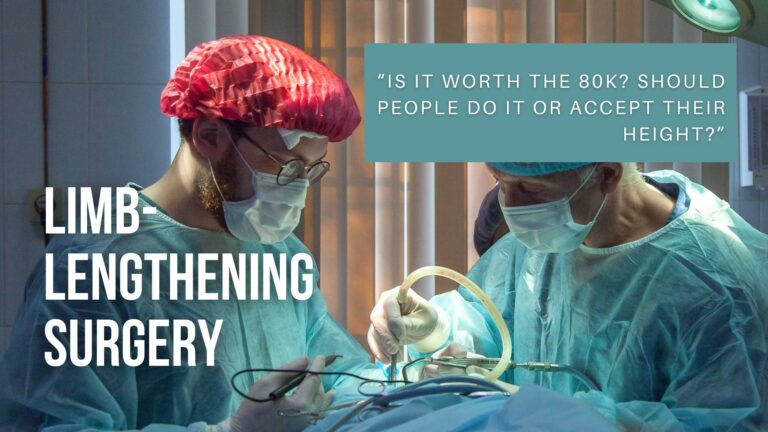
Limb-lengthening surgery: “Is it worth the 80k? Should people do it or accept their height?”
by
Rida Maheen
What is limb lengthening and how does it work?
Limb lengthening stimulates bone in a patient’s leg or arm to grow longer. This is done as a gradual process, so that the bones and soft tissues (skin, muscles, nerves, etc.) slowly increase in length 1. The procedure involves surgically cutting the bone and attaching a device that slowly pushes the two ends of the bone apart. As space opens up between these two ends, new bone grows to fill in the gap.
Often, patients undergo several cycles of lengthening over the course of several years, depending on their age, stage of growth, and amount of lengthening needed. Usually, limb lengthening is used to correct a leg length discrepancy (when one leg or arm is shorter than the other leg or arm)2.
A diagram of an intramedullary limb lengthening system which is tanstalled to non-invasively lengthen the limbs (Image liscended under creative commons by wikipedia).
Even though the typical rate of lengthening is 1 mm per day, each person responds differently to bone lengthening. Some people’s bones heal very quickly, and the regenerate bone may harden before treatment is completed. Whereas for others. the bones might take much longer to heal, and the regenerate bone might not have time to form.
While this surgery is typically done on people who have unequal limb lengths, it is however not an alien concept in the world of cosmetic surgery which addresses aesthetic concerns — known as cosmetic stature lengthening. Limb-lengthening is becoming a popular procedure as more cosmetic surgeons can grant patients’ wishes to be taller.
Potential Risks
Before a patient or family commits to limb lengthening, they need to be aware of what the procedure entails and its potential risks.
Limb lengthening puts patients at risk of nerve damage, muscle damage, joint contracture, dislocations, arthritis, fractures, deformity, blood vessel injury, and bone infection.
Is it worth the price, cost, and potential complications?
Limb lengthening was never designed to be a cosmetic procedure. However, there is no doubt that this procedure provides favorable height gain, patient satisfaction, and functional outcomes for individuals that can afford the surgery.
With social media being very popular and certain beauty standards set in place these days, we witness a fair number of individuals falling into the abyss of not being satisfied with their appearances and bodies. Not only that but also, we can witness heightism (yes, that’s a real term based on height discrimination) in our day-to-day lives.
Certain studies have found that taller individuals, particularly taller men, have higher levels of self-esteem and get paid more than shorter individuals 3, 4 And so different perceptions like taller people being perceived as more attractive, dominant, competent, authoritative, strong, and intelligent compared to shorter individuals, subsequently lead to increased self-esteem in taller individuals 5, 6.
Even across different cultures, taller stature is linked to increased social status. This study 7 concluded that human height is linked to stronger interpersonal dominance and may contribute to the relationship between height and social status that is widely observed among different societies.
Considering these insecurities and societal perceptions, all of them play a big part in height dysphoria and heightism which are big concerns that lead to a lot of youngsters wanting to opt for this painful procedure. Height dysphoria is a type of body image anxiety disorder caused by extreme dissatisfaction with one’s height.
A 17-year-old Indian teen had to undergo an additional 5 surgeries to fix the damage that his first surgery had left him with 8.
A Chinese man became permanently disabled after a botched leg-lengthening procedure left him with severe infections in his limbs. The 22-year-old travelled overseas to receive the surgery in a bid to become 5ft9 after feeling insecure about his height for years 9.
Those who have undergone the process say that the potential risks, the cost, and the pain are a small price to pay for what they gained – no longer feeling insecure.

Conclusion
While it is a good solution for people who are very short and insecure about their height, it should be avoided for people of average height because the more they do it, the more height they’ll crave, causing them to never accept themselves as who they are.
References
- Limb Lengthening: The Process | International Center for Limb Lengthening. https://www.limblength.org/treatments/limb-lengthening-the-process/.
- Limb-lengthening surgery: A look at the pros and cons – Boston Children’s Answers. https://answers.childrenshospital.org/limb-lengthening/.
- Judge, T. A. & Cable, D. M. The Effect of Physical Height on Workplace Success and Income: Preliminary Test of a Theoretical Model. (2004) doi:10.1037/0021-9010.89.3.428.
- Schick, A. & Steckel, R. H. Height, human capital, and earnings: The contributions of cognitive and noncognitive ability. Journal of Human Capital 9, 94–115 (2015).
- Size Matters! Body Height and Labor Market Discrimination: A Cross-European Analysis | Publication | CESifo. https://www.cesifo.org/en/publikationen/2009/working-paper/size-matters-body-height-and-labor-market-discrimination-cross.
- Re, D. E. et al. Apparent height and body mass index influence perceived leadership ability in three-dimensional faces. Perception 41, 1477–1485 (2012).
- Stulp, G., Buunk, A. P., Verhulst, S. & Pollet, T. v. Human height is positively related to interpersonal dominance in dyadic interactions. PloS one 10, (2015).
- Six “Make Me Tall” surgeries later, Mumbai teen can now barely walk. https://www.mid-day.com/mumbai/mumbai-news/article/six–make-me-tall–surgeries-later–mumbai-teen-can-now-barely-walk-16459173.
- Chinese man, 22, faces permanent disabilities after receiving botched leg-lengthening surgery | Daily Mail Online. https://www.dailymail.co.uk/news/article-8768805/Chinese-man-22-faces-permanent-disabilities-receiving-botched-leg-lengthening-surgery.html.
This article was written by Rida Maheen, the official blog manager of WEmpower Pakistan and Masters student at Tsinghua University, Beijing, China.



Recent Comments